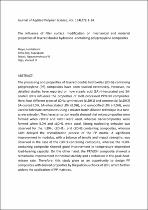 ResearchSpace
ResearchSpace
The influence of filler surface modification on mechanical and material properties of layered double hydroxide -containing polypropylene composites
JavaScript is disabled for your browser. Some features of this site may not work without it.
- ResearchSpace
- →
- Research Publications/Outputs
- →
- Journal Articles
- →
- View Item
| dc.contributor.author |
Moyo, Lumbidzani

|
|
| dc.contributor.author |
Ray, Suprakas S

|
|
| dc.contributor.author |
Sebati, Ngwanamohuba W

|
|
| dc.contributor.author |
Ojijo, Vincent O

|
|
| dc.date.accessioned | 2018-03-02T10:09:15Z | |
| dc.date.available | 2018-03-02T10:09:15Z | |
| dc.date.issued | 2017-03 | |
| dc.identifier.citation | Moyo, L. et al. 2017. The influence of filler surface modification on mechanical and material properties of layered double hydroxide -containing polypropylene composites. Journal of Applied Polymer Science, vol. 134(27): 1-14 | en_US |
| dc.identifier.issn | 0021-8995 | |
| dc.identifier.issn | 1097-4628 | |
| dc.identifier.uri | DOI: 10.1002/app.45024 | |
| dc.identifier.uri | http://onlinelibrary.wiley.com/doi/10.1002/app.45024/epdf | |
| dc.identifier.uri | http://hdl.handle.net/10204/10075 | |
| dc.description | Copyright: 2017 Wiley. Due to copyright restrictions, the attached PDF file only contains the abstract of the full text item. For access to the full text item, please consult the publisher's website. | en_US |
| dc.description.abstract | The processing and properties of layered double hydroxides (LDHs)-containing polypropylene (PP) composites have been studied extensively. However, no detailed studies have reported on how stearic acid (SA)-intercalated and SA-coated LDHs influence the properties of melt-processed PP/LDH composites. Here, four different types of LDHs: synthesized (cLDH1) and commercial (cLDH2) SA-coated LDH, SA-intercalated LDH (iLDH), and unmodified LDH (nLDH), were used to fabricate composites using a master-batch-dilution technique in a twin-screw extruder. The characterization results showed that microcomposites were formed when cLDH2 and nLDH were used, whereas nanocomposites were formed when iLDH and cLDH1 were used. Strong nucleating behavior was observed for the nLDH-, cLDH1-, and cLDH2-containing composites, whereas iLDH delayed the crystallization process of the PP matrix. A significant improvement in modulus, with a balance of tensile and impact strengths, was observed in the case of the cLDH1-containing composite, whereas the nLDH-containing composite showed good improvement in temperature-dependent load-bearing capacity. On the other hand, the PP/iLDH composite showed a remarkable improvement in thermal stability and a reduction in the peak-heat-release rate. Therefore, this study gives us an opportunity to design PP composites with desired properties by the judicious choice of LDH, which further widens the application of PP matrices. | en_US |
| dc.language.iso | en | en_US |
| dc.publisher | Wiley-Blackwell | en_US |
| dc.relation.ispartofseries | Worklist;20226 | |
| dc.subject | Flame retardance | en_US |
| dc.subject | Structure–property relationships | en_US |
| dc.subject | Thermal properties | en_US |
| dc.title | The influence of filler surface modification on mechanical and material properties of layered double hydroxide -containing polypropylene composites | en_US |
| dc.type | Article | en_US |
| dc.identifier.apacitation | Moyo, L., Ray, S. S., Sebati, N. W., & Ojijo, V. O. (2017). The influence of filler surface modification on mechanical and material properties of layered double hydroxide -containing polypropylene composites. http://hdl.handle.net/10204/10075 | en_ZA |
| dc.identifier.chicagocitation | Moyo, Lumbidzani, Suprakas S Ray, Ngwanamohuba W Sebati, and Vincent O Ojijo "The influence of filler surface modification on mechanical and material properties of layered double hydroxide -containing polypropylene composites." (2017) http://hdl.handle.net/10204/10075 | en_ZA |
| dc.identifier.vancouvercitation | Moyo L, Ray SS, Sebati NW, Ojijo VO. The influence of filler surface modification on mechanical and material properties of layered double hydroxide -containing polypropylene composites. 2017; http://hdl.handle.net/10204/10075. | en_ZA |
| dc.identifier.ris | TY - Article AU - Moyo, Lumbidzani AU - Ray, Suprakas S AU - Sebati, Ngwanamohuba W AU - Ojijo, Vincent O AB - The processing and properties of layered double hydroxides (LDHs)-containing polypropylene (PP) composites have been studied extensively. However, no detailed studies have reported on how stearic acid (SA)-intercalated and SA-coated LDHs influence the properties of melt-processed PP/LDH composites. Here, four different types of LDHs: synthesized (cLDH1) and commercial (cLDH2) SA-coated LDH, SA-intercalated LDH (iLDH), and unmodified LDH (nLDH), were used to fabricate composites using a master-batch-dilution technique in a twin-screw extruder. The characterization results showed that microcomposites were formed when cLDH2 and nLDH were used, whereas nanocomposites were formed when iLDH and cLDH1 were used. Strong nucleating behavior was observed for the nLDH-, cLDH1-, and cLDH2-containing composites, whereas iLDH delayed the crystallization process of the PP matrix. A significant improvement in modulus, with a balance of tensile and impact strengths, was observed in the case of the cLDH1-containing composite, whereas the nLDH-containing composite showed good improvement in temperature-dependent load-bearing capacity. On the other hand, the PP/iLDH composite showed a remarkable improvement in thermal stability and a reduction in the peak-heat-release rate. Therefore, this study gives us an opportunity to design PP composites with desired properties by the judicious choice of LDH, which further widens the application of PP matrices. DA - 2017-03 DB - ResearchSpace DP - CSIR KW - Flame retardance KW - Structure–property relationships KW - Thermal properties LK - https://researchspace.csir.co.za PY - 2017 SM - 0021-8995 SM - 1097-4628 T1 - The influence of filler surface modification on mechanical and material properties of layered double hydroxide -containing polypropylene composites TI - The influence of filler surface modification on mechanical and material properties of layered double hydroxide -containing polypropylene composites UR - http://hdl.handle.net/10204/10075 ER - | en_ZA |





